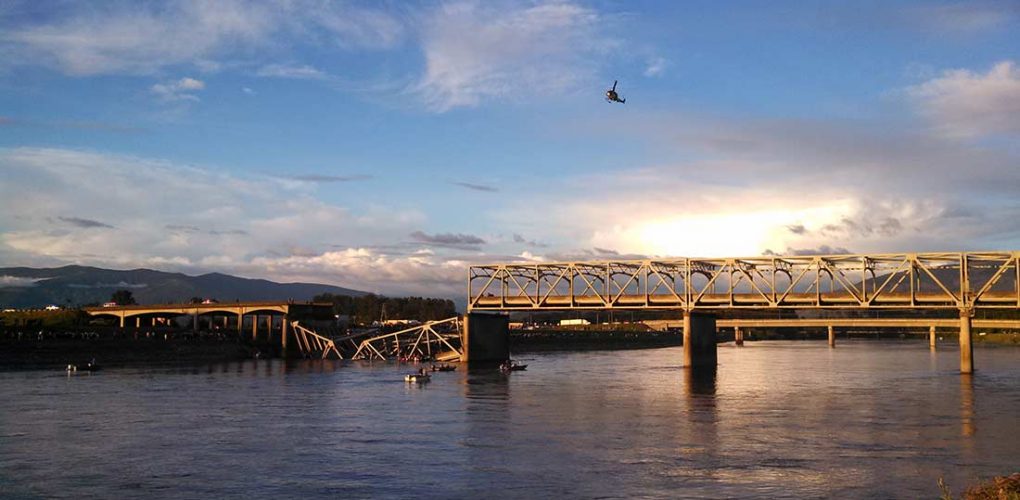Featured image By Martha T (05-23-13 Skagit Bridge Collapse) [CC BY 2.0], via Wikimedia Commons
Bridge failures can lead to injuries, loss of life, and property damage on a scale equal to plane crashes, terrorist attacks, and natural disasters. That’s why bridge designers, engineers, construction workers, managers, and inspectors take their jobs so seriously. The best way for them to prevent catastrophic accidents is to understand the factors that cause bridges to fail.
In this article, we’ll reveal the top reasons bridges become seriously compromised or collapse, along with lessons learned from ones that failed because of — or survived despite — these factors.
1. A combination of issues
The top reason bridges fail is a mix of factors that, if they happened individually, would not cause a bridge to collapse. However, when they take place all at once, they result in devastating consequences. For example, severe winds may not be enough to cause a structure to come down. However, when they hit a bridge that’s structurally too rigid to withstand them, it leads to failure.
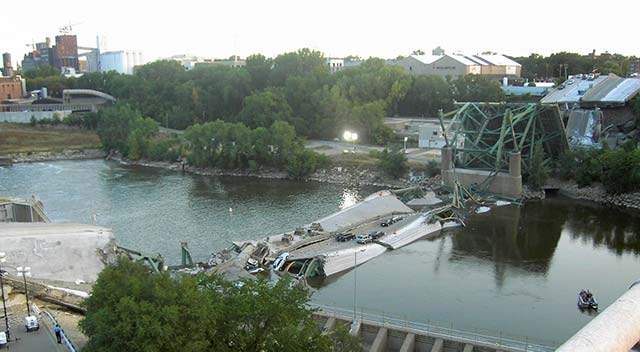
By Mike Wills (Flickr) [CC BY-SA 2.0], via Wikimedia Commons
The I-35W Mississippi River Bridge in Minneapolis collapsed suddenly in August 2007. The official cause was attributed to gusset plates that were too thin and tore along a line of rivets.
The issue: The plates had supported heavy traffic volume for 40 years. It took a secondary factor, the additional weight of construction equipment parked on the bridge at the time, to trigger the failure. Another contributor: Wear and tear on the gussets had not been identified prior to construction starting because bridge inspections had been missed.
So, while the gussets were identified as the root cause of this devastating collapse, it was really three separate factors coming together that led to disaster.
2. Infrastructure issues
According to the American Society of Civil Engineers, bridges in the United States earn a mediocre C+ rating for maintenance and safety. The group reports that one out of every nine bridges in the country is considered structurally deficient, and the average age of bridges in the U.S. is more than 42 years old. The age and condition of bridges is a contributing factor to many recent collapses.
One positive: Modern equipment makes it easier to inspect aging bridges to look for potential structural issues.
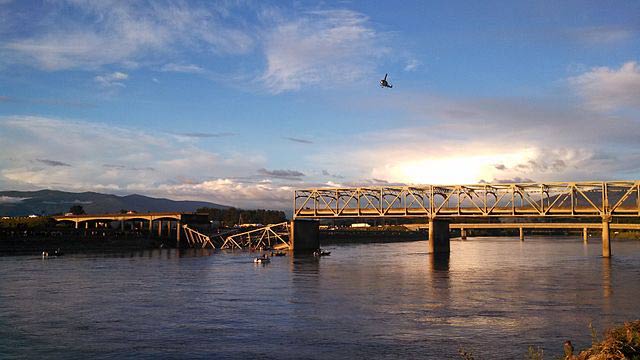
Image By Martha T (05-23-13 Skagit Bridge Collapse) [CC BY 2.0], via Wikimedia Commons
The collapse of the I-5 Skagit River Bridge in 2013 is blamed on infrastructure-related problems. An oversized load crossing the bridge was the immediate cause of the incident. However, many weight restrictions had been placed on vehicles crossing the bridge because it had been declared functionally obsolete. This designation means it did not have the redundant structures and systems that would be required if the bridge were to be built today. The collapse could have been avoided if the antiquated bridge had been reinforced or replaced sooner, leveraging today’s safer standards.
3. Floods
Today’s changing climate and the extreme weather events associated with it are causing more flood-related damage to bridges. Most of this damage isn’t from water alone. During a flood, rivers pick up debris, such as trees and buildings, and push it forcefully against bridges, causing their foundations to wash away and structural elements to break apart.
Most collapses happen on bridges that were built a long time ago when designers couldn’t imagine the kind of storms they’d have to withstand today. This is an important lesson for bridge designers. They must plan structures and drainage systems that can hold up against today’s storms and potentially more extreme weather events in the future.
Extreme rain in Louisiana in August 2016 caused significant flood-related damage to the Walsh Road and Stein Road bridges in Tangipahoa Parish, requiring them to be replaced. While damage to two relatively small local bridges may not seem like a big issue, closing them for more than six months caused significant economic impact to an area recovering from the storms. Better planning, including installing storm drainage systems or bridge reinforcements, could have avoided this hardship.
4. Unexpected events
When it comes to bridge construction, engineers simply don’t know what they don’t know. Countless bridge incidents happen because of unanticipated structural or design-related issues.
The good news: Computer modeling and testing make it easier for engineers to see how different bridge designs hold up against a broad range and combination of unexpected conditions. Still, it’s important for them to build redundancies into structures to cover unknown possibilities in today’s fast-changing world.
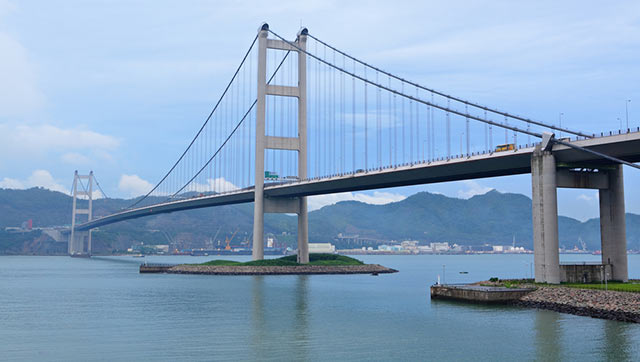
The Tsing Ma Bridge in Hong Kong is among the longest suspension bridges in the world. It’s built on a site that experiences earthquakes, extreme winds, rough water, and typhoons. Prior to being completed in 1997, it underwent significant scale model, wind tunnel, and computer testing. This led to innovations that improved the design of this bridge and others that followed.
5. Accidents
Whether it’s a truck hitting a support post, a train falling off the tracks or a boat colliding into a foundation, accidents are one of the leading reasons bridges are damaged or come down. Bridge engineers must plan for all types of incidents, including those caused by vehicles that exist today and ones like driverless cars, larger ocean tankers, and cruise ships, along with pilotless drones that could impact bridges in the near and distant future.
Back in 1982, a plane took off from Washington National Airport and 30 seconds later, crashed into the 14th Street Bridge over the Potomac River. Seven vehicles traveling on the bridge were struck by the plane and drove into the freezing water. Four of the people in them perished. Amazingly, only a few hundred feet of guardrail and wall from the side of the bridge were torn away. This is a testament to the strength and durability of the structure built near the center of the nation’s capitol.
6. Construction incidents
Some bridges never make it to completion. They fail during construction. A lesson learned from these incidents is that it’s just as important for designers and engineers to plan all aspects of bridge construction step by step, analyzing the impact new phases will have on previous ones.
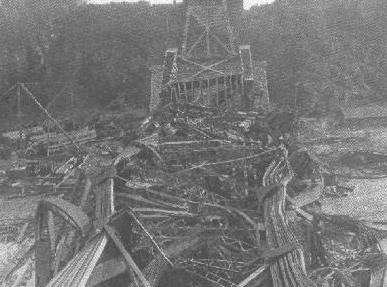
Back in 1907, an epic bridge failure happened during construction in Quebec City. Designers were made aware that the bridge weighed eight million pounds more than estimated at a certain point in the construction process. However, they didn’t feel this was a significant enough issue to make adjustments. Soon after, an onsite engineer noticed the frame of the bridge was starting to bend. However, others didn’t take the observation seriously, claiming the beams were bent when they were delivered. Not long after, the structure came down, killing 75 workers. In the end, it was determined that the beams were not adequate to handle the additional eight-million-pound load.
7. Design flaws and manufacturing errors
While it’s becoming less common than in the past, some bridges fail almost immediately after completion due to significant design errors or issues associated with materials used in the construction process. Frequent inspections throughout the construction process can provide the “fresh eyes” needed to identify problems and flaws. New types of lifts and equipment make it easier for inspectors to get to hard-to-reach areas of bridges.
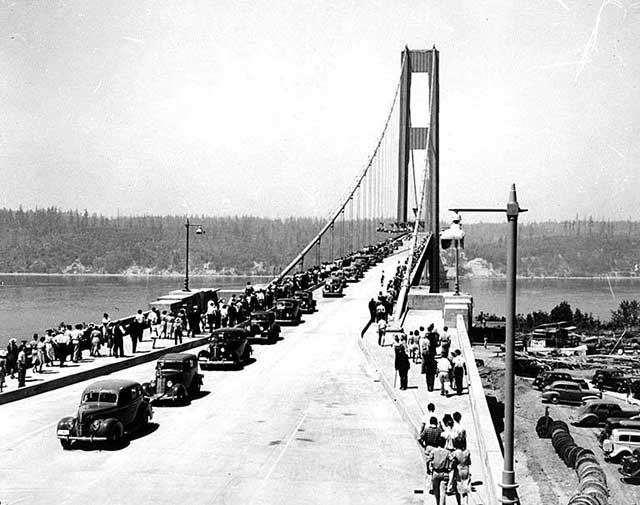
The original Tacoma Narrows Bridge was built to cross the Puget sound in Washington state in 1940. Almost four months after opening to the public, it collapsed into the water.
The issue: A design flaw caused it to shake violently in the wind. This bridge, nicknamed “Galloping Gertie,” is still referenced in engineering textbooks as an example of how NOT to build bridges in extreme wind areas.
8. Fires
Fires used to be a much bigger contributor to bridge failures than they are today. The reason? More bridges used to be constructed of highly flammable wood. However, fires can still take down a bridge, especially when truck or tanker collisions or construction incidents 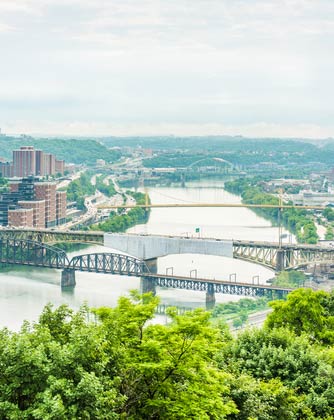 lead to extremely hot fires that can melt steel infrastructure components.
lead to extremely hot fires that can melt steel infrastructure components.
One step bridge designers can take to avoid super-heated conflagrations: protect utility infrastructure on bridges so gas, electrical and other utility lines don’t cause or contribute to fires.
The 88-year-old Liberty Bridge in Pittsburgh was damaged significantly because of a construction-related fire in September 2016. A spark from a welding tool ignited a highly flammable plastic pipe and tarp. The fire burned so hot, it bent a critical 30-foot-long steel beam by six inches. The beam was designed to support 2.4 million pounds of pressure. Bracing and heat treatments were required to bring it back into structural alignment.
9. Earthquakes
Although rare, bridge collapses caused by earthquakes can be devastating. Swaying bridges or collapsed sections of them are often the iconic video and still images that people associate with these powerful natural events. Bridge engineers have found ways to build bridges that are lighter and add flexibility and rigidity in the right places that make it more likely to survive even the most violent quakes and aftershocks.
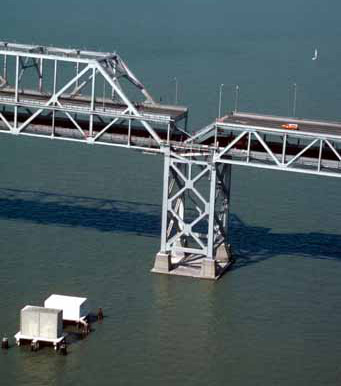
Who can forget the pictures of the section of the San Francisco – Oakland Bay Bridge that fell down during the Loma Prieta earthquake in 1989? Fortunately, the devastating collapse cost only a single life. Significant improvements were made to the bridge after the incident, including replacing existing rivets with stronger, heat-treated ones and adding diagonal box beams that provide greater stability when the bridge sways side to side.
Conclusion
The best way to avoid bridge failures is to expect them to happen and plan for them. It’s the only way to protect the public from injuries, loss of life, property damage, and destruction. Interested in learning about ways to improve bridge design and construction quality? Contact an experienced supplier to find out more.

